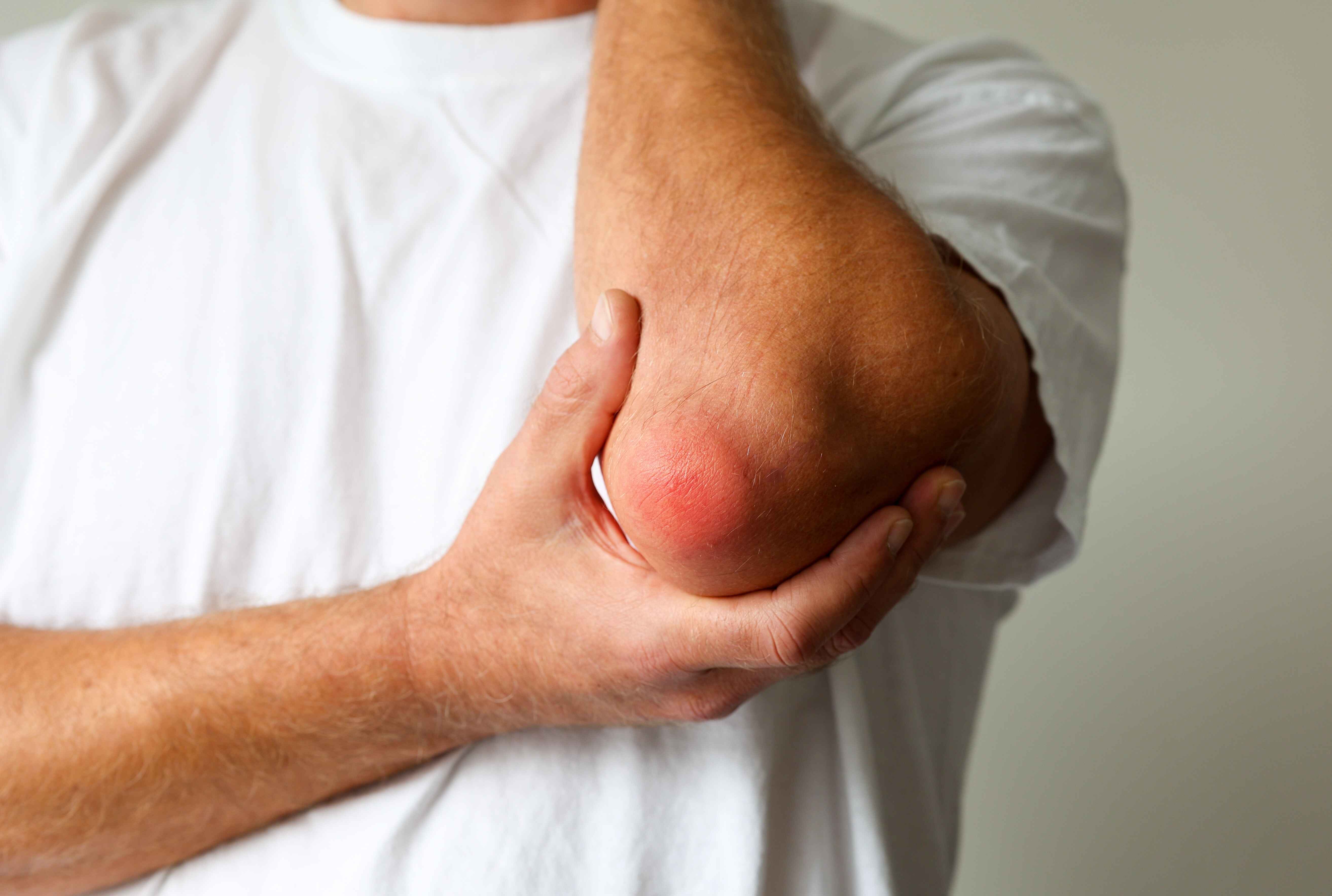Written By: Dr. Mohamed Ghanem
Dr. Mohamed Ghanem is a Specialist in the Department of Orthopaedics. He completed his MBBS from Mansoura University in Egypt and his Master's degree in Orthopaedic and Trauma Surgery (MSc) from Benha University also in Egypt. He is a member of the AO TRAUMA Gulf Cooperation Council, the AO SPINE Gulf Cooperation Council and the Egyptian Orthopaedic Association (EOA).
Updated On:January 26, 2025
Read more.

What is Bursitis?
A painful swelling known as bursitis occurs in the bursa, a little sac filled with fluid. The plural form of the bursa, bursae, fills in the crevices between bones and other tissue. They act as a kind of bubble cover for the body's structures. The gaps between bones and your muscles, tendons, or skin, are padded by bursae.
Bursitis develops when a bursa swells and becomes inflamed. Overuse and excessive pressure on a bursa are the most frequent causes of bursitis. An inflamed bursa can cause pain that either appears suddenly or gradually worsens over time.
Types of Bursitis
There are various distinct types of bursitis, including the following:
- Anterior Achilles tendon bursitis
- Posterior Achilles tendon bursitis
- Hip bursitis
- Elbow bursitis
- Knee bursitis
- Kneecap bursitis
Causes of Bursitis
Bursitis is frequently brought on by repeated motions, such as a pitcher pitching a baseball or a worker moving heavy boxes. Spending a lot of time kneeling or in other positions that impose pressure on a particular body region might also contribute to it. Although less frequent, bursitis can also be brought on by wounds and infections.
Bursitis may result from certain activities, such as:
- Carpentry
- Cultivating and raking
- Incorrect leg length, bone spurs, or joint arthritis may result in bad posture or an incorrectly positioned joint or bone
- Painting
- Playing musical instruments
- Playing sports like baseball, golf, and tennis
- Scrubbing
- Shoveling
Symptoms of Bursitis
Most typical signs and symptoms of bursitis include:
- Pain, especially while moving the physical portion that is being impacted
- A constrained range of motion (how far a body part can move)
- Swelling
- Redness or discoloration of your skin
- A sensation of heat or warmth
- Fever
- Chills
When to see a doctor for Bursitis?
In the event that you experience chronic joint discomfort, a rash, excessive swelling, redness, or bruising in the affected area, or a sudden inability to move a joint especially when you exercise or push yourself, sharp or shooting pain, or fever, it would be best to consult with a doctor.
Bursitis Risk Factors
Bursitis can strike anyone. People who are more susceptible to getting it are:
- Athletes
- People who perform manual or physical labor
- Musicians
Bursitis is more likely to occur in people who have specific medical conditions, including:
- Gout and psoriatic arthritis
- Diabetes
- Thyroid condition
Age is also considered a risk factor for bursitis.
Bursitis Complications
Bursitis complications can include the following:
- Chronic inflammation and pain can result from a bursa that has become permanently thickened or enlarged as a result of untreated bursitis.
- Atrophy of the surrounding muscles might result from a joint that has been inactive for a long time.
Bursitis Diagnosis
Bursitis can be identified by a physical examination by a medical professional. They will enquire about your symptoms and look over the affected portion of your body. If your profession or hobby requires you to do a repetitive motion, mention this to your healthcare physician along with what you were doing when you first noticed symptoms.
To determine whether you have bursitis, your doctor may order a few tests, such as:
- X-rays to obviate any further conditions
- An ultrasound or MRI to find enlarged bursae,
- An examination of the blood for infection
- A bursa aspiration (taking a sample of fluid) if they believe it is contaminated.
Bursitis Treatment
Usually, bursitis gets better on its own. Comfort can be achieved by conservative measures like rest, ice, and pain medication. In the event that precautionary measures fail, you might need to:
- Medication. Your doctor could advise taking an antibiotic if the bursitis you have is the result of an infection.
- Therapy. Strengthening the muscles in the affected area with physical therapy or exercises can reduce pain and stop recurrence.
- Injections. Your hip or shoulder discomfort and inflammation can be reduced by a corticosteroid injection into the bursa. One injection is frequently sufficient for this treatment, which typically takes effect rapidly.
- Auxiliary equipment. The injured area will feel less pressure if a walking cane or other aid is used temporarily.
- Surgery. Surgery is occasionally required to drain an inflamed bursa, although seldom is it essential to remove the afflicted bursa entirely.
Bursitis Prevention
Even though not all forms of bursitis are preventable, you can lessen your risk and the intensity of flare-ups by altering the way you perform several jobs. Examples comprise:
- Putting knee protectors on. If your profession or pastime requires a lot of kneeling, consider wearing some sort of padding to lessen the strain on your knees.
- A proper lift. When lifting, flex your knees. Your hip bursae are put under additional strain if you don't do this.
- Wheeling large weights. The bursae in your shoulders are stressed when you carry big loads. Instead, use a wheeled cart or a dolly.
- Taking breaks frequently. Repetitive jobs should be alternated with breaks or other activities.
- Maintaining a healthy weight. Your joints experience extra stress if you are overweight.
- Exercising. Muscle development can aid in the protection of your injured joints.
- Warm-up. Before engaging in strenuous exercises, warm up and stretch to prevent your joints from harm.
References
Aaron, D. L., Patel, A., Kayiaros, S., & Calfee, R. (2011). Four common types of bursitis: diagnosis and management. JAAOS-Journal of the American Academy of Orthopaedic Surgeons, 19(6), 359-367.
Blackwell, J. R., Hay, B. A., Bolt, A. M., & Hay, S. M. (2014). Olecranon bursitis: a systematic overview. Shoulder & Elbow, 6(3), 182-190.
Lustenberger, D. P., Ng, V. Y., Best, T. M., & Ellis, T. J. (2011). Efficacy of treatment of trochanteric bursitis: a systematic review. Clinical journal of sport medicine: official journal of the Canadian Academy of Sport Medicine, 21(5), 447.
Stell, I. M. (1999). Management of acute bursitis: outcome study of a structured approach. Journal of the Royal Society of Medicine, 92(10), 516-521.
Meet our doctors from the Orthopaedics department
|
||||||||
|
||||||||
|
||||||||
|
||||||||
|
||||||||
|
||||||||
|
||||||||
|
||||||||
|
||||||||
|
||||||||
|
||||||||
|
||||||||
|
||||||||
|
||||||||
|
||||||||
|
||||||||
|
||||||||
|
||||||||
|
||||||||
|
||||||||
|
||||||||
|
||||||||
|
||||||||
|
||||||||
|
||||||||
|
||||||||
|
||||||||
|
||||||||
|
||||||||
|
||||||||
|
||||||||
|
||||||||
|
||||||||
|
||||||||
|
||||||||
|
||||||||
|
||||||||
|
||||||||
|
||||||||
|
||||||||
|
||||||||
|
||||||||
|
||||||||
|
||||||||
|
||||||||
|
||||||||
|
||||||||
|
||||||||
|
||||||||
Similar Posts
teleMEDCARE App
Download teleMEDCARE app from Google Play or App Store to connect immediately to Medcare doctors at a click of a button and without an appointment.

Home Services
We offer our patients a broad range of home health care services in the comfort of their own homes. Book an appointment for lab tests, vaccinations, nurses and physiotherapists.

Chronic Care
Know more about our Chronic Care Management Programme in partnership with Damana Saicohealth.

teleMEDCARE App mobile
Download teleMEDCARE app from Google Play or App Store to connect immediately to Medcare doctors at a click of a button and without an appointment.

Home Services
We offer our patients a broad range of home health care services in the comfort of their own homes. Book an appointment for lab tests, vaccinations, nurses and physiotherapists.

Spotii
We have partnered with Spotii to offer a more flexible way to pay - Pay over time for your purchase. No interest, no cost & no catch.
























































